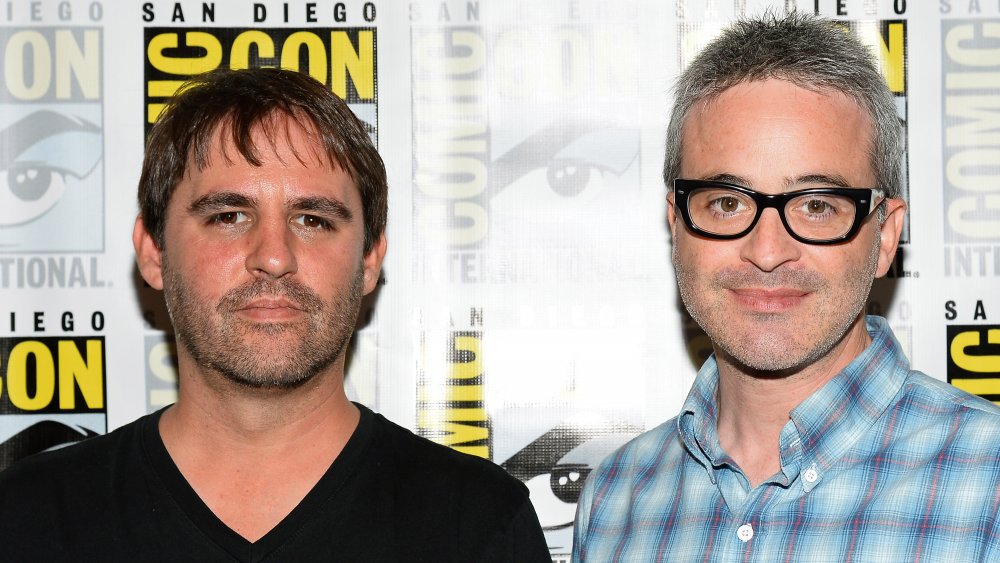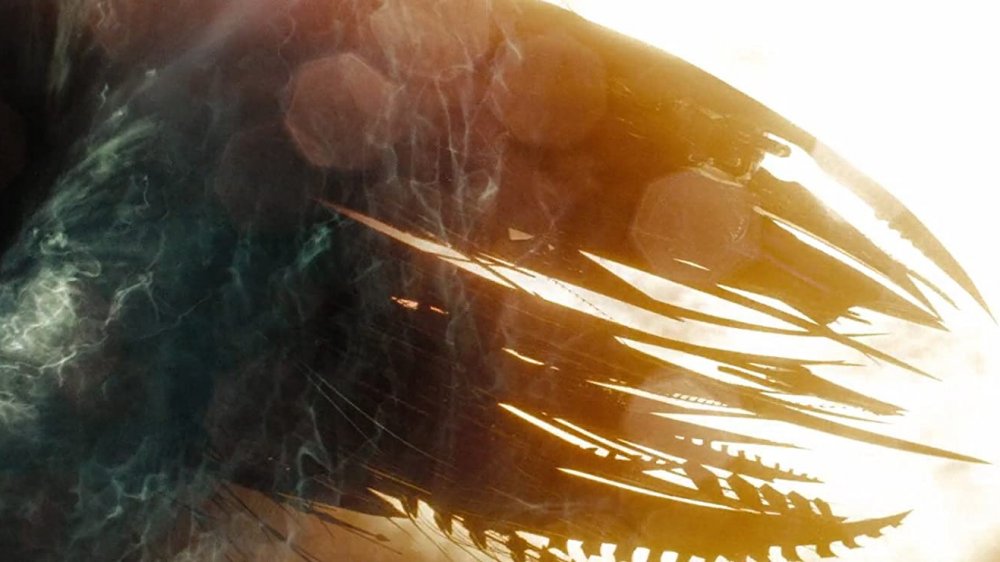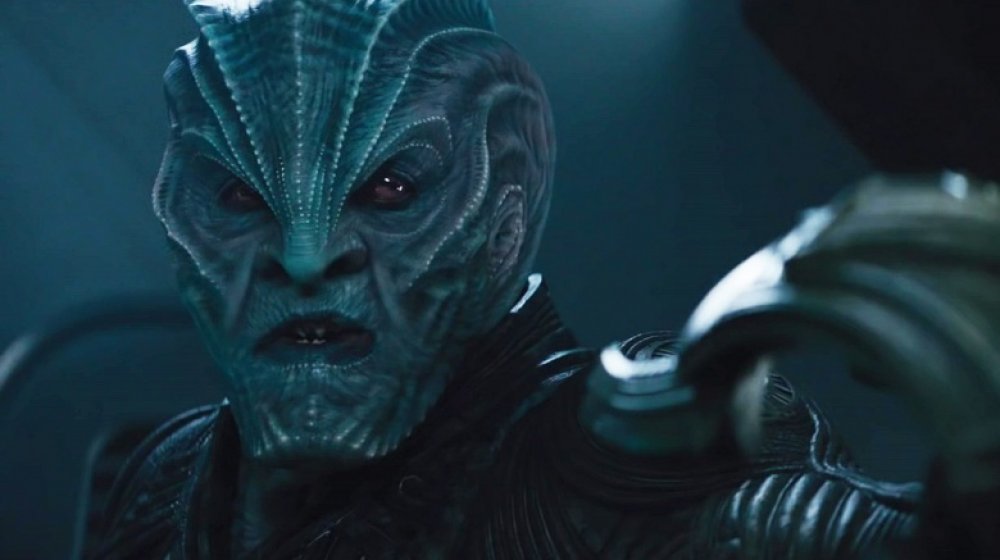The Star Trek Kelvin Timeline Explained
In 2009, Paramount Pictures released Star Trek, the first film in what would become a new action-oriented trilogy to reinvigorate the franchise at the worldwide box office. Directed by J.J. Abrams and starring Chris Pine, Zachary Quinto, and Zoe Saldana, Star Trek introduced the world to new versions of classic characters like Kirk, Spock, and Uhura, and it took us back to their earlier days in Starfleet. This wasn't just another reboot, though. Thanks to the heavy sci-fi influence of the original series, this version of Star Trek was actually presented in the form of an alternate timeline, with its roots in events of the original universe and one of the franchise's original characters.
Later dubbed "the Kelvin timeline" because of its connection to a destroyed Federation starship called the U.S.S. Kelvin, this alternate reality set the stage for three different Star Trek feature films, all of which remixed original series continuity in some form or another. Plus, in recent years, the inciting incident for this reality has become a jumping-off point for more stories in the Prime Star Trek reality, making it a major influence in two different universes. From its explosive origins to its broader implications, this is Star Trek's Kelvin timeline, explained
The real-world origins of the Kelvin timeline
In the late 2000s, Star Trek was in need of a re-invigoration. The last feature film in the franchise, Nemesis, came out in 2002, and the prequel TV series, Star Trek: Enterprise, went off the air in 2005, leaving the legendary sci-fi property without a major live-action media presence for the first time in years. Ultimately, Paramount Pictures decided the way to bring Trek back was a prequel film ... but not just a typical prequel. The film that would become 2009's Star Trek fell into the hands of screenwriters Roberto Orci and Alex Kurtzman, who decided to use time travel to create an alternate reality that would both raise the stakes for their "prequel" concept of a younger Kirk and Spock and also allow them to take some creative liberties with the well-worn characters.
Speaking with Sci Fi Wire in 2009, Kurtzman explained, "Yeah, the biggest thing I think we all hiccuped on, just conceptually, when Trek was presented to us was, 'Well, we know how they all died. We know what happened to them.' And when you know that, it's very difficult to put them in jeopardy in a way that feels fresh or original. How do you ever have real stakes to your characters?" Well, the answer was the introduction of an alternate reality that would link the new Star Trek film series to past canon, while also allowing filmmakers to go their own way.
The Kelvin timeline has its roots in tragedy
The story of Star Trek's Kelvin timeline began in the Prime Star Trek universe in the 2380s, when it became clear that the Romulan sun presented a major danger not just to the Romulan Star Empire but to a whole quadrant of the galaxy. The sun was nearing the end of its life and would soon go supernova, which would in turn destroy Romulus and other nearby worlds. Desperate to save their people, the Romulans asked the United Federation of Planets for help.
When evacuation efforts failed, Spock — now an ambassador from his homeworld of Vulcan — intervened in 2387 with his own attempt to halt the supernova through the use of red matter. Spock was able to stop the supernova's expansion but not before Romulus was destroyed, something he'd promised he could prevent. Enraged, a Romulan mining ship captain named Nero sought vengeance, and he attacked Spock's one-man vessel with his own ship, the Narada. During the pursuit, both ships were pulled through the black hole left in the wake of the supernova, which sent them back in time.
The fate of the U.S.S. Kelvin
Unbeknownst to Nero, when the Narada was drawn into the black hole, the Romulan ship was sent back to 2233, more than 150 years in the past. But the dude was still very angry. Nero's rage then focused on the first Federation vessel he found, the U.S.S. Kelvin. As the Romulan vessel attacked, First Officer George Kirk took command of the Kelvin after the death of his captain, and he sacrificed the ship to protect the escape shuttles fleeing the area, including the one carrying his wife and newborn son, James Kirk. The Kelvin was destroyed, and Nero's reign of terror continued in what was now an alternate reality.
As you've probably guessed, the Kelvin Ttmeline is so named because the destruction of the Kelvin is the event triggering the alternate reality. In the Kelvin timeline, life unfolds in a way that's quite recognizable for longtime Star Trek fans but with many differences interspersed throughout the universe. The starships look similar, for example, but the designs are altered in many ways, and the same is true of things like phasers, communicators, and Starfleet uniforms.
A different Kirk
In the Prime Star Trek timeline, James T. Kirk's path to captaining the U.S.S. Enterprise is noteworthy but very conventional. Kirk entered Starfleet in part because of his father, but George Kirk was still very much alive when he signed up, and once Kirk was a part of Starfleet, he spent quite a bit of time doing other things before joining the Enterprise, including a stint as an Academy instructor and serving on the U.S.S. Farragut.
In the Kelvin timeline, though, the absence of Kirk's father sent him off on a very different path, one with much less conviction and certainty early on. This version of James T. Kirk was a rebellious young man, joyriding in stolen cars as a teenager and getting into bar fights in his 20s. His Starfleet journey actually began when one of these fights was broken up by Captain Christopher Pike, a Starfleet officer familiar with Kirk's history and his father's heroism. Pike — who was also Kirk's predecessor as captain of the Enterprise in the Prime timeline, under very different circumstances — urged young James to do something with his life because his father sacrificed himself to make sure Kirk would live and accomplish something meaningful. Spurred on by Pike, Kirk joined Starfleet and eventually tricked his way onto the newly launched Enterprise after cadets in the Academy were called into service to help battle Nero.
Now, there are two Spocks
While Nero arrived in the Kelvin timeline in 2233, Spock didn't actually emerge from the black hole until 25 years later, and he found the vengeful Romulan waiting for him. Nero captured Spock's ship, the Jellyfish, and left the Vulcan stranded on the icy planet Delta Vega, with the intention of making Spock watch his own homeworld perish just as Nero had to watch Romulus fall. Nero achieved this by drilling into Vulcan's core with his ship's machinery, then shooting red matter into it. Vulcan collapsed as the Kelvin timeline version of Spock attempted to evacuate as many of his people as he could. He was able to save his father but not his human mother, who fell just as they were preparing to beam back up to the Enterprise.
A short time later, Kirk was also marooned on Delta Vega by an irate Spock, who was acting captain of the Enterprise and had already discerned Nero was a time traveler. Here, Kirk met the Prime timeline version of Spock, who used a Vulcan mind meld to reveal to him the explanation for Nero's presence, including the destruction of Romulus and the black hole he journeyed through. Eventually, both Spocks met each other and attempted to rebuild Vulcan culture through their shared knowledge and experience. With Spock Prime's help — including the introduction of transwarp beaming to the Kelvin timeline — Kirk and Spock were able to make amends and defeat Nero before he could destroy Earth, cementing the dynamic of the Enterprise crew.
A warlike Federation
The sudden destruction of Vulcan and the losses in the Federation fleet during the battle with Nero, coupled with the growing hostility of the Klingons, spurred certain factions within Starfleet to seek a more militaristic approach to dealing with the future of the galaxy. In 2258 and 2259, Admiral Alexander Marcus went to great lengths to pursue this more warlike approach in secret, and he began exploring the galaxy for various resources to use for the defense of Starfleet. Marcus' search eventually led to the discovery of Botany Bay and a group of enhanced superhumans in cryogenic stasis.
Desperate to advance his cause, Marcus roused the leader of the group, Khan Noonien Singh, and held the rest of Khan's people hostage while Khan himself was forced to develop advanced weapons for the Federation under the secretive Section 31. This included the development of the Vengeance, a powerful new Federation warship, and a new advanced torpedo design that Marcus hoped to use against the Klingons.
Khan tried to smuggle his people out of Marcus' care by hiding them, still in stasis, in the torpedoes, but Marcus discovered this plan. Certain that the admiral had already killed his people, Khan set out to become a one-man vengeance machine and destroy the Federation from the inside.
The wrath of Khan
Operating under the name John Harrison, Khan staged successful attacks on Starfleet facilities that resulted in the death of Admiral Christopher Pike. After this attack, Marcus saw a path to killing his former hostage and covering up his military conspiracy at the same time. He dispatched Kirk and the Enterprise to capture "Harrison" on the Klingon world Kronos, believing Kirk would simply kill the terrorist as an act of revenge. This set Kirk, Spock, and the Enterprise crew on a new, alternate trajectory to a confrontation with their old Prime universe foe.
At fist, Harrison/Khan tried to present himself as an ally to Kirk and Spock before finally turning on them when he felt he could safely extract his still-living crewmates from their torpedoes. The resulting confrontation led to Kelvin timeline Spock seeking the advice of Spock Prime, who recalled the deadly consequences of battling Khan. In the Prime timeline, it was Spock who paid with his life before being revived. In the Kelvin timeline, though, it was Kirk who sacrificed his life in the battle with Khan. Fortunately, Spock was able to defeat Khan through some clever deception, and Dr. Leonard McCoy was able to use Khan's blood, which had strange restorative properties, to revive Kirk.
The clash with Krall in the Kelvin timeline
After the battle with Khan, the Enterprise crew in the Kelvin timeline set out for their own version of the five-year mission we saw in Star Trek: The Original Series, and three years into that mission, they encountered something interesting (particularly from our perspective as observers), something with a backstory that extended far back into the timeline, before the universes diverged.
In Star Trek Beyond, the Enterprise crew discovers the buried U.S.S. Franklin, a Federation starship that was lost decades earlier, in an era before the Kelvin incident diverged the timelines. That means that, since the alternate reality doesn't really split until 2233, the loss of the Franklin is something we can consider to exist in both timelines. What happens after that — including the Enterprise's encounter with Krall, the mutated former captain of the Franklin — is part of the Kelvin timeline only, which means another version of Starfleet could encounter the Franklin in the Prime universe and theoretically have a different outcome. It's an intriguing idea spinning out of the fun sci-fi adventure story that Beyond offers.
Star Trek Beyond also offers another intriguing detail regarding the Kelvin timeline's Spock. Early in the film, he's considering leaving Starfleet to have a more direct role in redeveloping Vulcan culture. After learning that Spock Prime has died, though, he chooses to honor his alternate self's memory by remaining in Starfleet, as it's what Spock Prime was doing at the same age.
How the Kelvin timeline has impacted the Prime timeline
The Kelvin timeline of Star Trek is fascinating for a number of reasons, including the fact that it didn't have to exist this way at all. The writers of 2009's Trek film could have simply said, "We're starting over, but the other films and shows are all still there for you to watch." They didn't do that, instead leaning into the science fiction of it all. That means we have an inciting incident for the Kelvin timeline that also exists as a major, galaxy-altering event in the Prime timeline, and that means there are consequences for both realities.
For a long time, those consequences weren't directly explored in Star Trek live-action storytelling, but that changed with the 2020 series Star Trek: Picard. Set in the decades following Star Trek: The Next Generation, the series follows the latter-day adventures of Jean-Luc Picard, and it reveals that his departure from Starfleet was directly tied to the Romulan sun disaster. Though many in the Federation opposed it, Picard spearheaded a massive evacuation effort to get as many people off Romulus as possible in the years before the supernova, only to have his rescue fleet destroyed by a surprise attack from a group of rogue synths. Starfleet dropped the rescue effort entirely in the aftermath, and Picard resigned.









